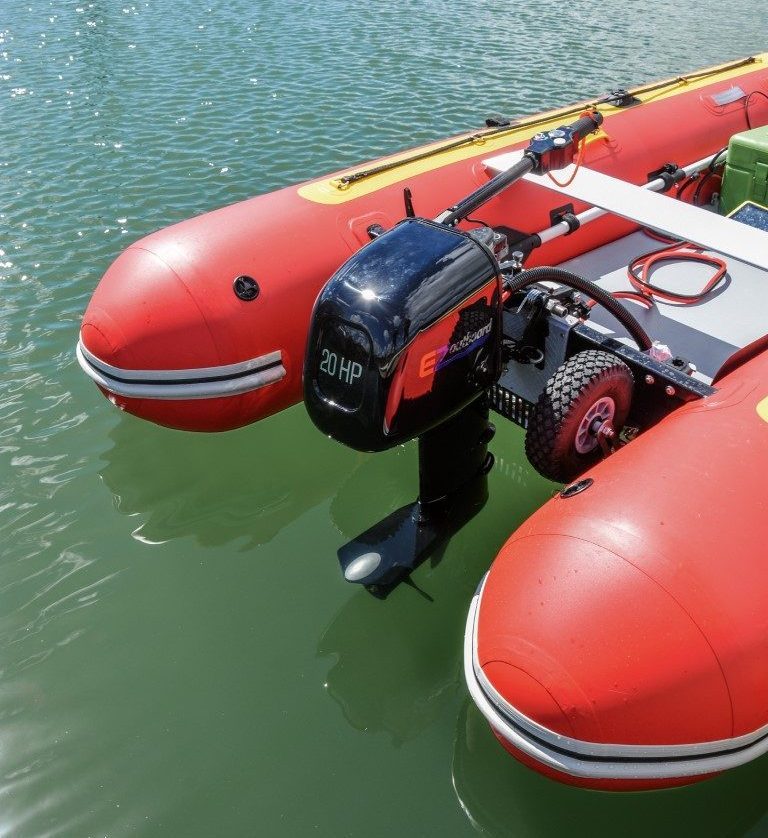

EZoutboard is a newcomer to the portable electric outboard scene, offering high performance on a budget.
The NZ Electric Boat Company runs a fleet of electric hire boats on the Kerikeri River. Company founder Chris Claydon also imports and distributes a range of marine electric propulsion systems, including bolt-on sail- and pod-drives, hybrid systems and electric inboards from Dutch company Combi, plus electric outboards from Torqeedo and newcomer EZoutboard, one of which is featured here.

The EZoutboard that Chris demonstrated is the 48-volt EZ 20 model with a nominal 20hp equivalent power rating, optimised for high speed – much higher than most other ‘portable’ electric outboards. As Chris points out, “Everybody wants to go fast!” On a yacht tender or small auxiliary craft, it can replace a 15hp petrol outboard and provide similar or better performance.
The EZoutboard is also available in 6hp and 10hp equivalent versions – the motor casing cowlings are slightly different across the models to accommodate differently rated electric motors.
Manufactured in China, EZoutboards house the electric motor at the top, rather than in the propeller hub. The motor is cooled by a sealed circulating freshwater system that sheds heat through the immersed leg – the same principle as keel cooling.
Unlike some electric outboards, which use off-the-shelf outboard motor legs and mechanicals, EZoutboard legs are custom-made. Incorporating water passages for engine cooling and an oil-free belt drive transmission, they are completely maintenance-free. And since the custom leg accommodates standard Mercury props, finding exactly the right propeller for your vessel is easy, says Chris.

The clamp-on EZ 20 is adjustable for short or long shaft applications and the tiller handle offers a range of height and reach adjustment, as well as three operation modes. Eco mode pushes the boat up to hull speed while Normal is for everyday operation. Obviously, Sport mode unlocks the motor’s full power potential and delivers its high-speed performance.
However, like any electric propulsion system, speed/thrust comes at a cost: battery life. For the demonstration Chris used an improvised battery set-up comprising four 50Ah batteries with 10kWh capacity – far more than is necessary for most applications. He typically supplies EZoutboard packages that include the motor and two lightweight EZoutboard 30Ah or 50Ah lithium LiFePo4 batteries, plus cables and connectors.

Batteries weigh between 17 and 26kg each. Two, three or more batteries can be used to increase range and endurance – two 50Ah batteries provide the EZ 20 with several hours of normal operation and 30 minutes at full speed.
We tried the EZ 20 clamped to the transom of a TrueKit Discovery 400 inflatable catamaran tender/dinghy. The outboard looks solidly built and proved easy to operate – much like a conventional petrol outboard, in fact. The operation mode is selected using a dial on the tiller while forward, neutral or reverse is selected by twisting the handle grip one way or the other – more twist equals more speed. The operator’s magnetic ‘safe key’ attached to the safety lanyard must be engaged to operate the motor.
Switching between modes on the fly is easy – Chris recommends starting off in Eco or Normal mode if manoeuvring in close quarters before switching up. With all the motor’s torque and power instantly available at a twist of the throttle, it’s easier to control the thrust in one of the lesser modes.

A joystick remote control is also available for remote-steer installations. Voltage, amps, remaining battery capacity, motor rpms, motor temperature and the mode currently selected can be graphically displayed on a mobile device via Bluetooth using the EZoutboard app.
The three modes provide quite different boating experiences: Eco is fine for tootling around the marina or manoeuvring near the dock, Normal provides a decent turn of speed without excessively draining the batteries, while Sport really gets the Discovery up and running. Two adults onboard, plus extra batteries, we achieved perhaps 20 knots – impressive performance for an electric outboard.
Impressive too is the price, which starts at around $7,000 plus GST for the EZ 20 (motor only) or $4,150 for the EZ 6 ($5,620 plus GST with one battery). A typical EZ 20 set-up with two 50Ah batteries will set you back around $12,000 plus GST.
Compared to other electric outboards, that’s great value.





